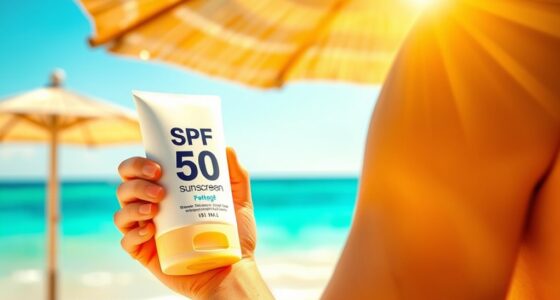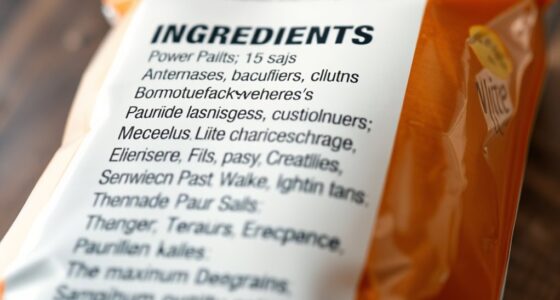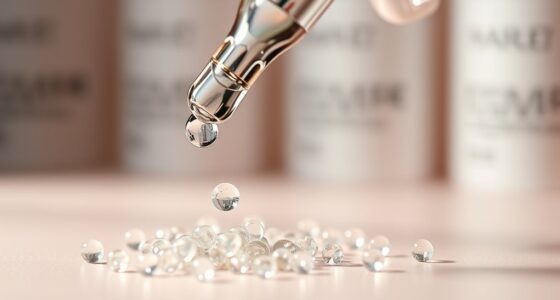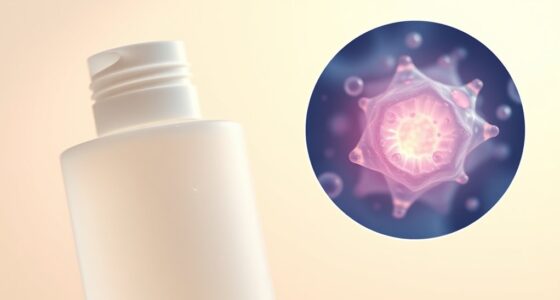Sunscreen helps protect your skin from harmful UV rays through various filters—chemical ones absorb UV radiation, while mineral ones reflect it. SPF indicates how long your skin is protected compared to no sunscreen, with SPF 30 blocking about 97% of UVB rays. Broad-spectrum sunscreens defend against both UVA and UVB rays, offering all-encompassing protection. Knowing how these work can help you choose the right product—keep going to discover more about staying safe in the sun.
Key Takeaways
- Sunscreen protects against UV damage, preventing sunburns and long-term skin aging.
- Broad-spectrum sunscreens shield against both UVA (aging) and UVB (burning) rays.
- SPF indicates how much longer skin is protected; higher SPF offers more UVB protection.
- Chemical filters absorb UV rays, while mineral filters reflect and scatter them; combining enhances protection.
- Proper application, reapplication, and choosing suitable SPF and filters are essential for effective sun defense.

Sunscreen is your first line of defense against the sun’s harmful rays, which can cause skin damage and increase the risk of skin cancer. When you step outside, UV protection becomes essential to prevent immediate and long-term skin issues. UV rays, particularly UVA and UVB, penetrate your skin and damage its cells, leading to premature aging, sunburns, and more serious health concerns. Choosing the right sunscreen means understanding how it shields your skin from these rays, reducing the chances of damage. A good sunscreen forms a barrier that absorbs or reflects UV radiation, keeping your skin safer as you enjoy outdoor activities.
Sunscreen is essential for protecting skin from UV damage and skin cancer risks.
The key to effective UV protection lies in selecting a sunscreen with broad-spectrum coverage. Broad-spectrum sunscreens guard against both UVA and UVB rays, addressing the full spectrum of UV exposure. UVA rays penetrate deep into the skin, contributing to premature aging and skin cancer, while UVB rays mostly affect the surface, causing sunburns. By opting for broad-spectrum protection, you guarantee your skin is shielded from the full range of UV damage. This is especially important if you’ll be outdoors for extended periods or during peak sunlight hours when UV intensity is highest.
Another crucial factor is SPF, or Sun Protection Factor. SPF indicates how long you can stay in the sun without getting sunburned compared to unprotected skin. For everyday use, dermatologists recommend at least SPF 30, which blocks about 97% of UVB rays. If you’re spending a lot of time outdoors, especially during midday, choosing a higher SPF can offer added protection. Remember, however, that SPF isn’t a license to stay in the sun indefinitely; it’s just a measure of how well the sunscreen can protect you from UVB rays. Proper application is vital—use enough sunscreen (about a teaspoon for your face and a shot glass for your body), and reapply every two hours or after swimming or sweating.
Understanding the role of different filters can also help you pick the right product. Chemical filters like avobenzone and oxybenzone absorb UV radiation, converting it into heat and releasing it from your skin. Mineral filters such as zinc oxide and titanium dioxide, on the other hand, reflect and scatter UV rays away from your skin. If you have sensitive skin or prefer natural options, mineral sunscreens often cause fewer irritations. Combining these filters can provide comprehensive UV protection, minimizing the risk of skin damage and keeping your skin healthier over time. Additionally, filter technology continues to evolve, offering consumers more effective and skin-friendly options.
In essence, choosing a broad-spectrum sunscreen with adequate SPF and proper application is your best strategy for UV protection. It greatly reduces your risk of skin damage caused by UV exposure and helps you maintain healthier skin in the long run.
Frequently Asked Questions
How Often Should I Reapply Sunscreen During the Day?
You should reapply sunscreen every two hours during the day, especially if you’re outdoors or sweating. It’s important to contemplate application timing—apply it generously 15 minutes before sun exposure. If you’re swimming or sweating heavily, reapply immediately afterward and more frequently if needed. Regular reapplication ensures continuous protection, so keep a travel-sized bottle handy to maintain your SPF coverage and stay safe in the sun.
Can Sunscreen Prevent All Skin Damage and Aging?
Sunscreen can’t prevent all skin damage and aging, but it markedly boosts your UV protection efficacy and helps with skin cancer prevention. You should still seek shade, wear protective clothing, and avoid peak sun hours. Regular reapplication is essential, especially after sweating or swimming. Combining these habits maximizes your protection, reducing premature aging and the risk of skin cancer, even if sunscreen isn’t foolproof.
Are Mineral Sunscreens Better for Sensitive Skin?
Imagine a gentle shield protecting your skin—mineral sunscreens often act like that for sensitive skin. They’re typically better than chemical sunscreens because mineral options, like zinc oxide and titanium dioxide, are less likely to cause irritation. If you have sensitive skin, you’ll probably find mineral sunscreens more comfortable, as they sit on your skin’s surface rather than penetrate it, reducing the risk of allergic reactions or irritation.
What Ingredients Should I Avoid in Sunscreens?
You should avoid sunscreens with chemical filters like oxybenzone, avobenzone, and octocrylene, as they can cause skin irritation or hormonal disruptions. Also, steer clear of harmful preservatives such as parabens and formaldehyde releasers, which may lead to allergic reactions or long-term health concerns. Look for products with mineral filters and gentle, natural ingredients to protect your skin safely and effectively.
Does SPF 50 Provide Twice the Protection of SPF 25?
SPF 50 doesn’t provide twice the protection of SPF 25. In SPF comparison, SPF 50 blocks about 98% of UVB rays, while SPF 25 blocks around 96%. So, the increase in protection isn’t proportional. Sunscreen effectiveness improves with higher SPF, but the difference isn’t as dramatic as the numbers suggest. To maximize protection, apply generously and reapply regularly, regardless of SPF number.
Conclusion
So, staying safe in the sun is simple with a solid sunscreen. Select a suitable spectrum, slather on a suitable SPF, and stay protected from pesky UV rays. Remember, regular reapplications and careful coverage keep your skin safe and sound. Shield yourself smartly, stay stylish, and savor sunny days without stress. Sunscreen isn’t just a product—it’s your shield, your safeguard, your secret to sun-savvy, stunning skin!








